Abstract
The costs of disconnection between the basic and applied sectors of behavior analysis are reviewed, and some solutions to these problems are proposed. Central to these solutions are collaborations between basic and applied behavioral scientists in programmatic research that addresses the behavioral basis and solution of human behavior problems. This kind of collaboration parallels the deliberate interactions between basic and applied researchers that have proven to be so profitable in other scientific fields, such as medicine. Basic research questions of particular relevance to the development of behavioral technologies are posed in the following areas: response allocation, resistance to change, countercontrol, formation and differentiation/discrimination of stimulus and response classes, analysis of low-rate behavior, and rule-governed behavior. Three interrelated strategies to build connections between the basic and applied analysis of behavior are identified: (a) the development of nonhuman animal models of human behavior problems using operations that parallel plausible human circumstances, (b) replication of the modeled relations with human subjects in the operant laboratory, and (c) tests of the generality of the model with actual human problems in natural settings.
Keywords: basic–applied continuum, integrating basic and applied research, matching theory, behavioral momentum, stimulus equivalence, countercontrol, low-rate behavior, discrimination, differentiation, technology development
Full text
PDF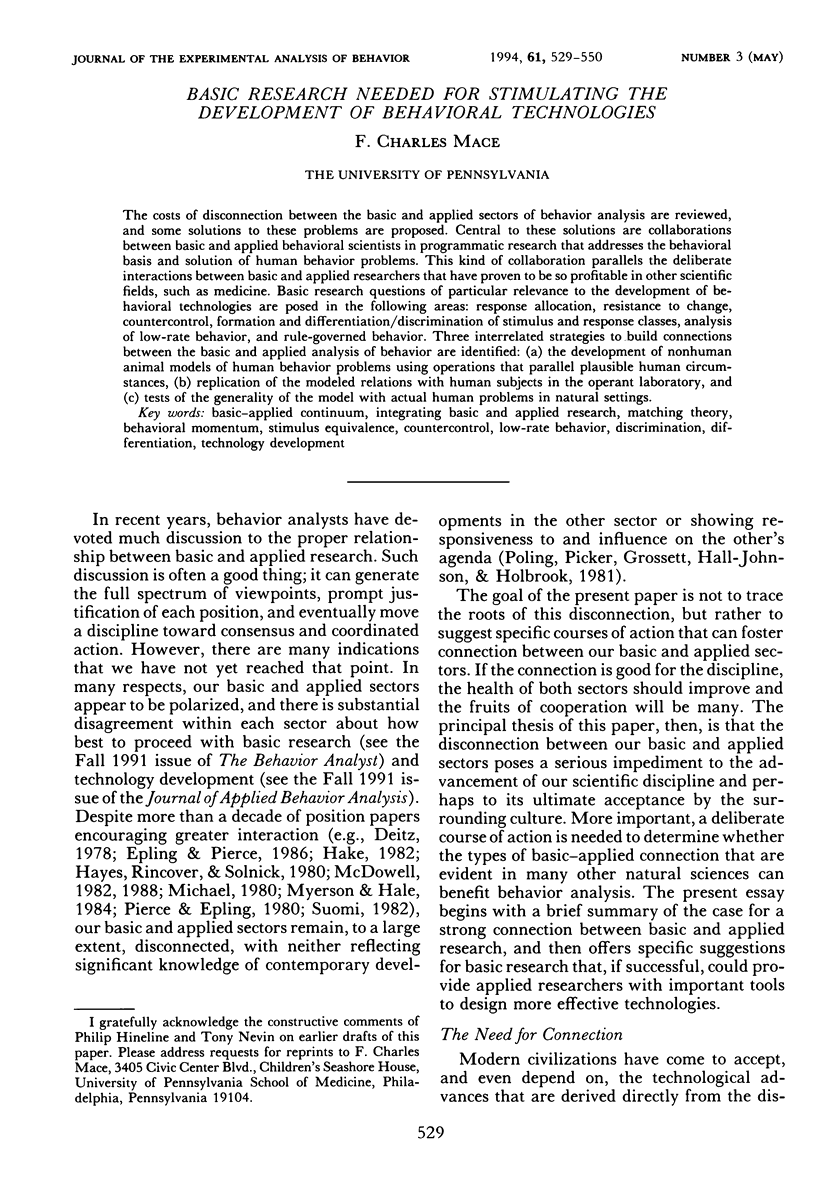
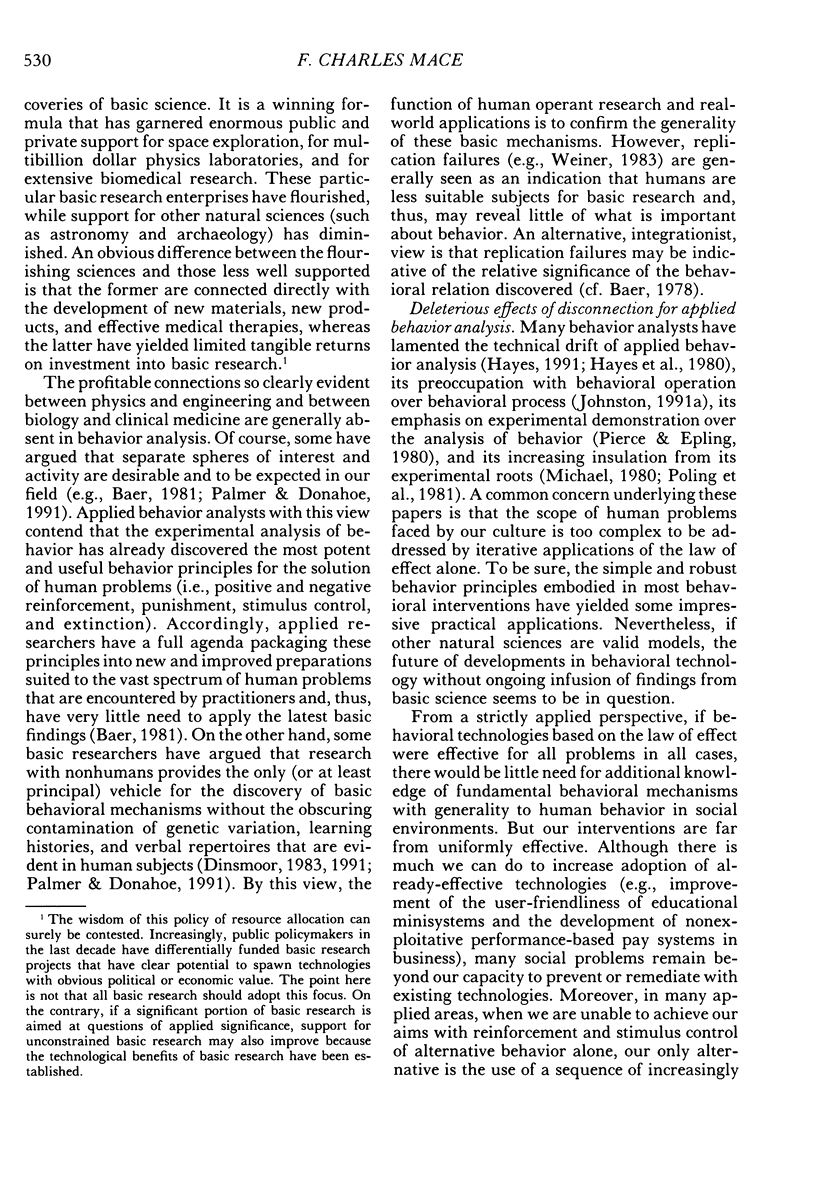
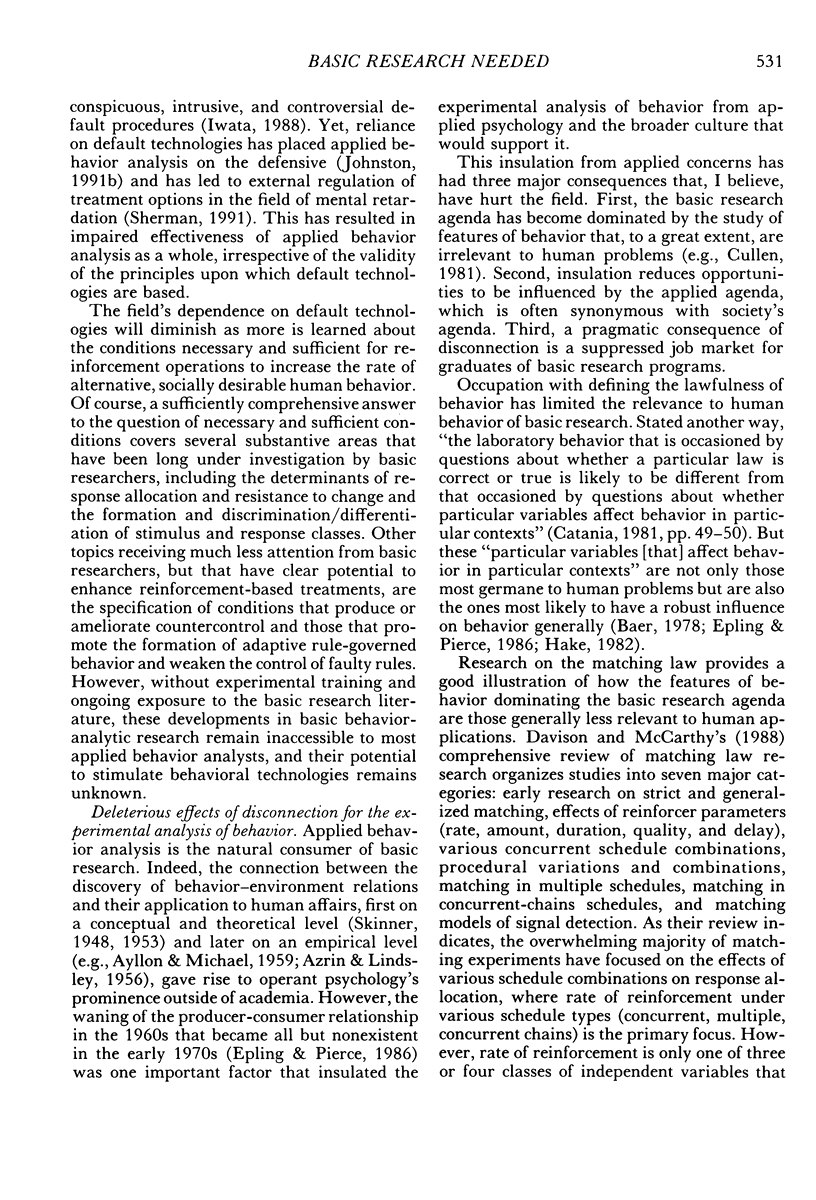
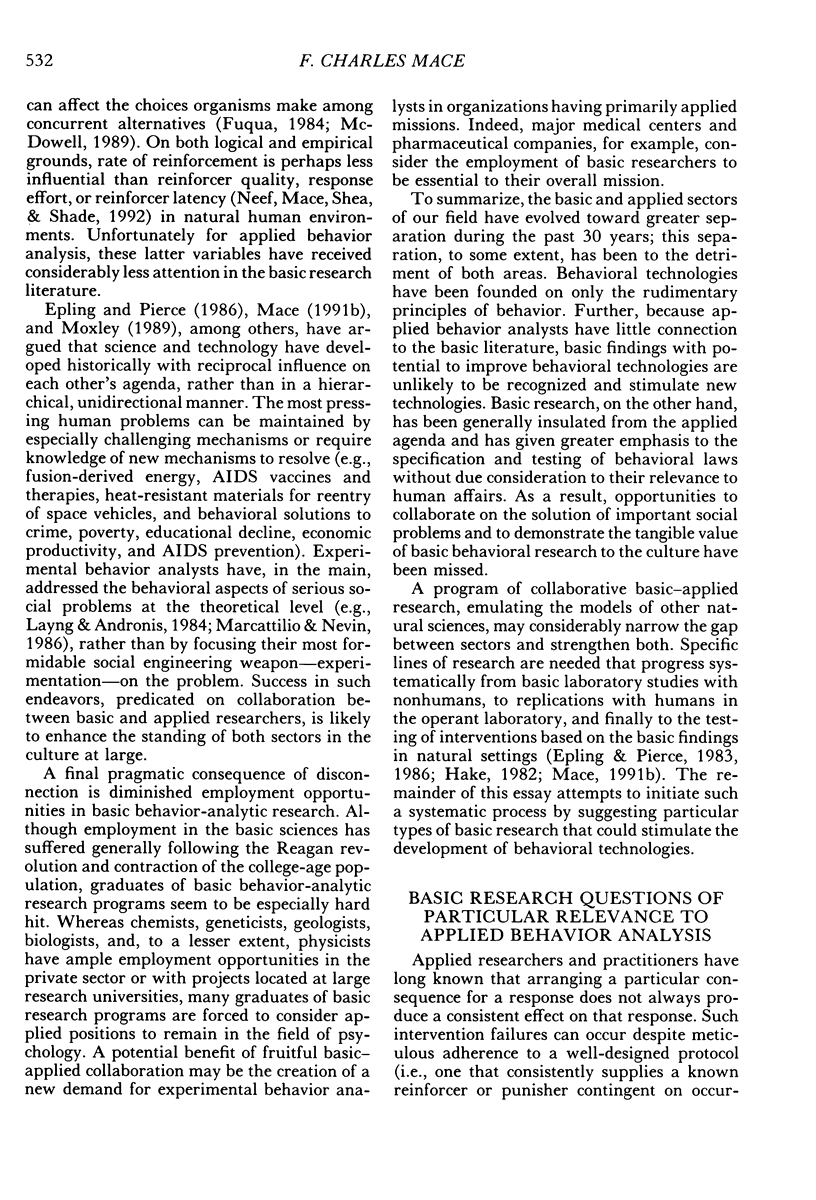
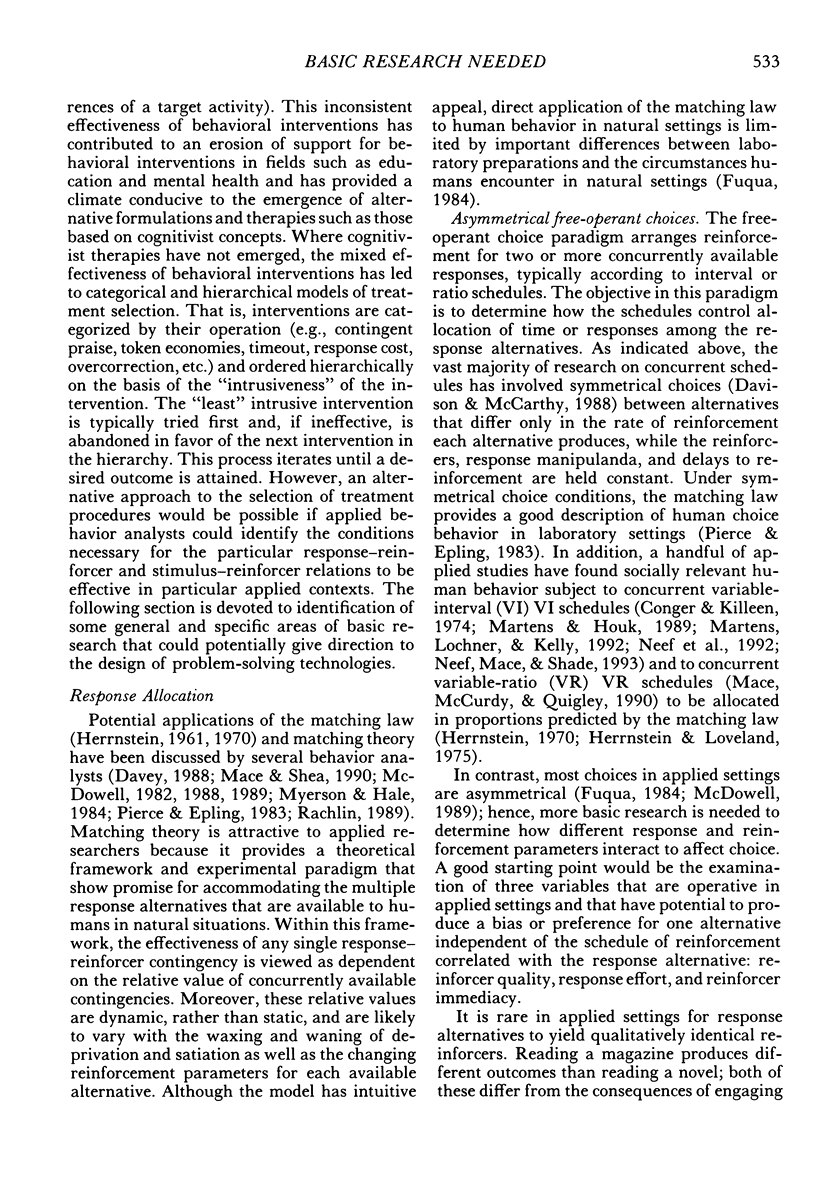
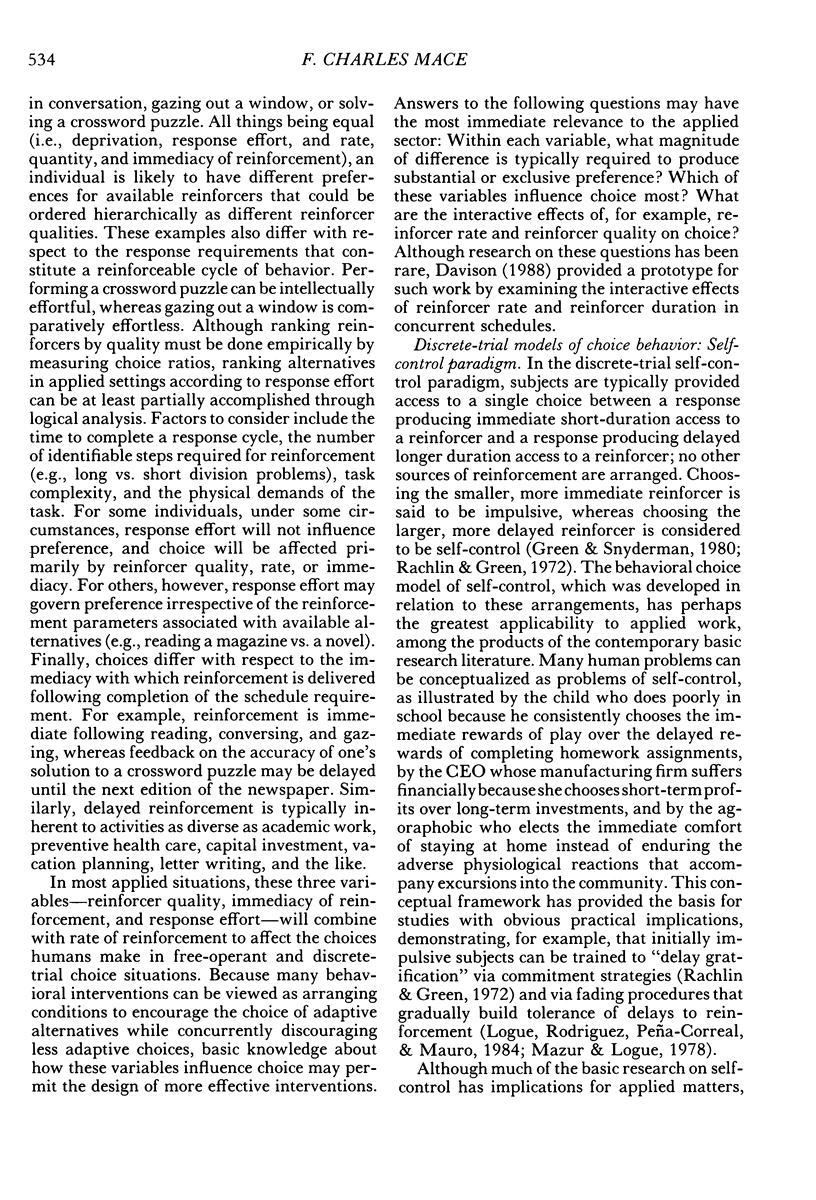
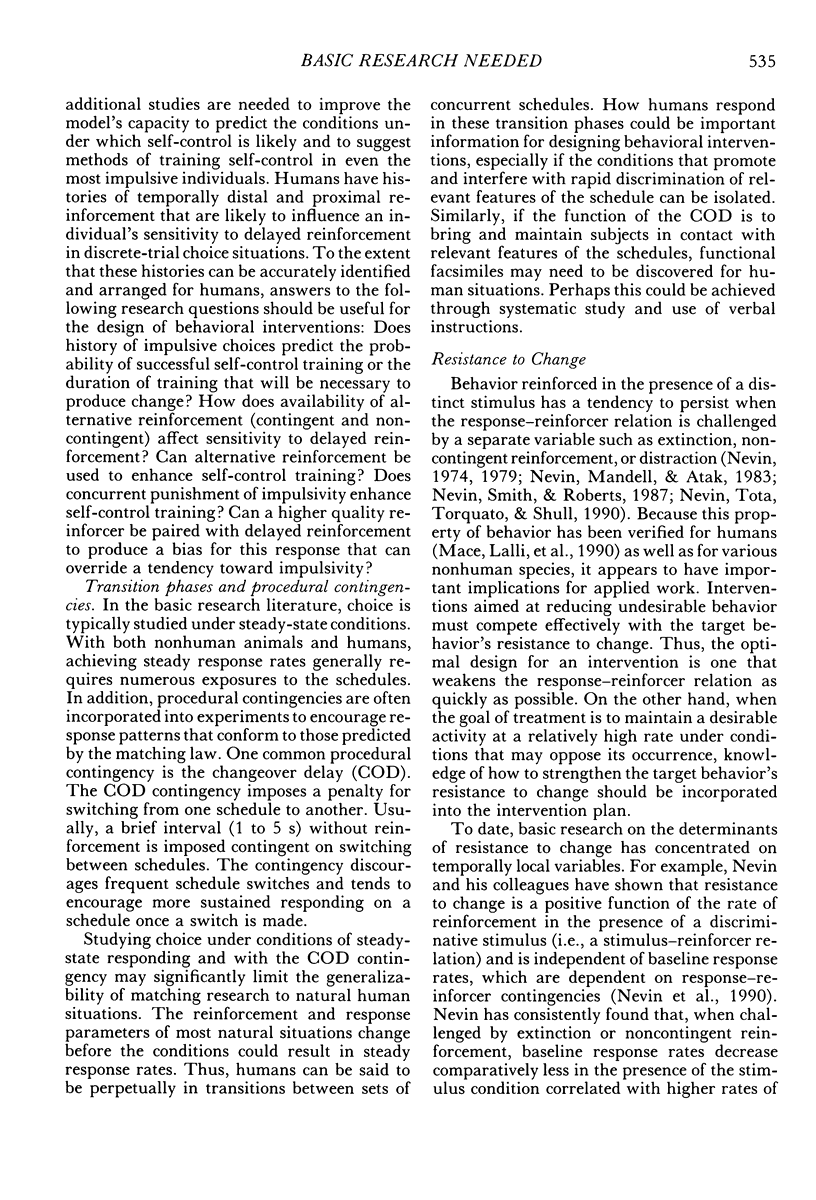
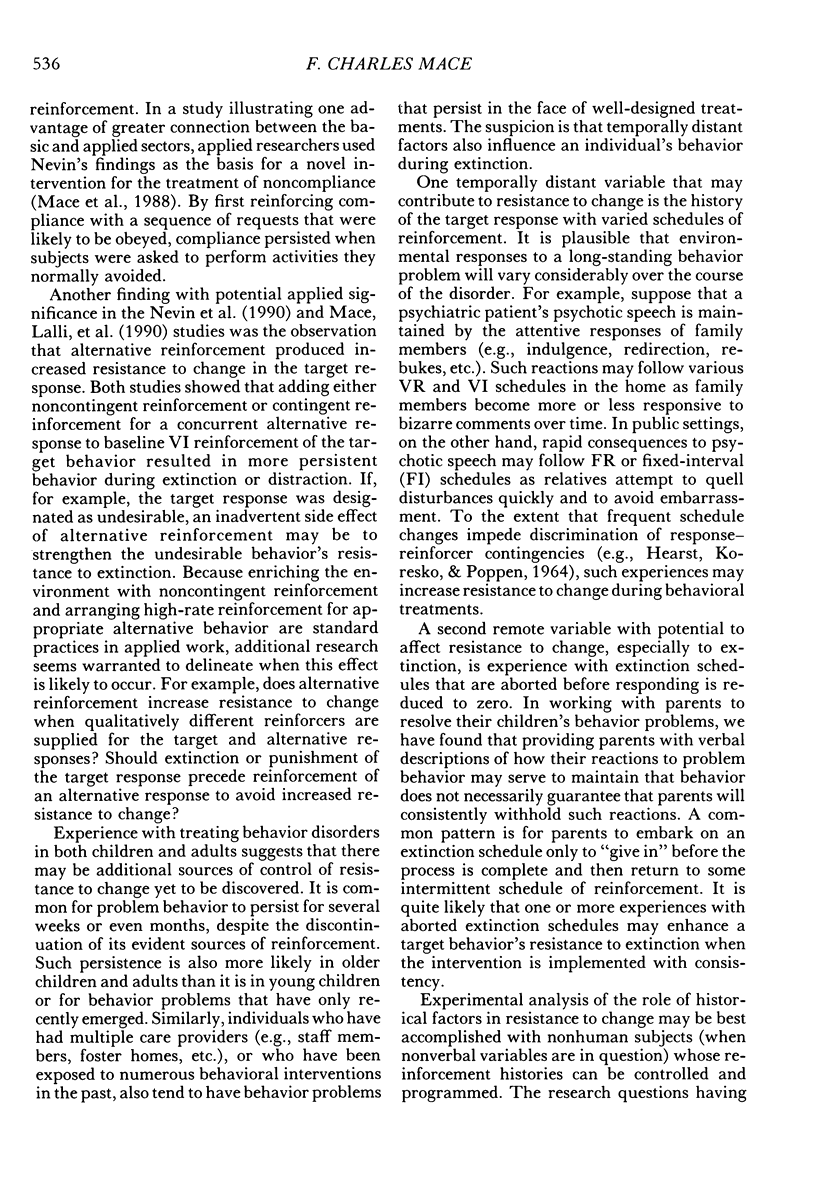
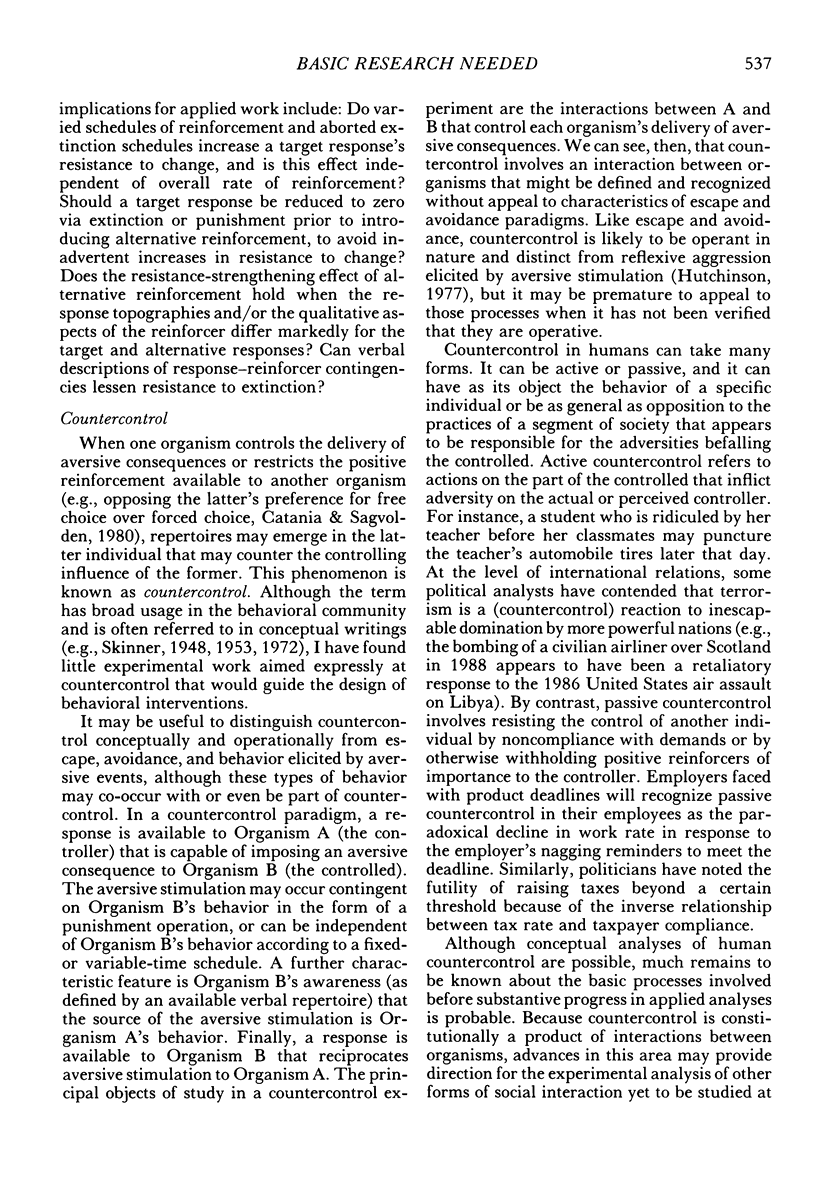
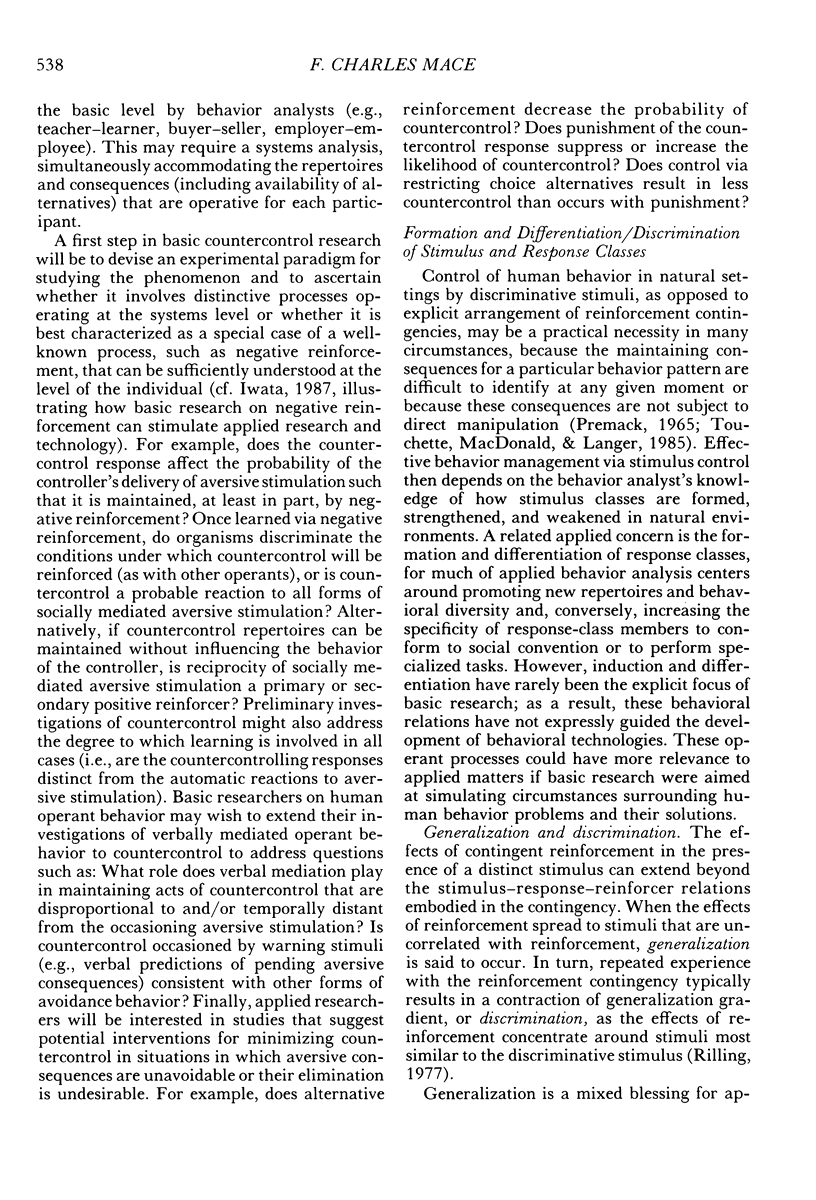
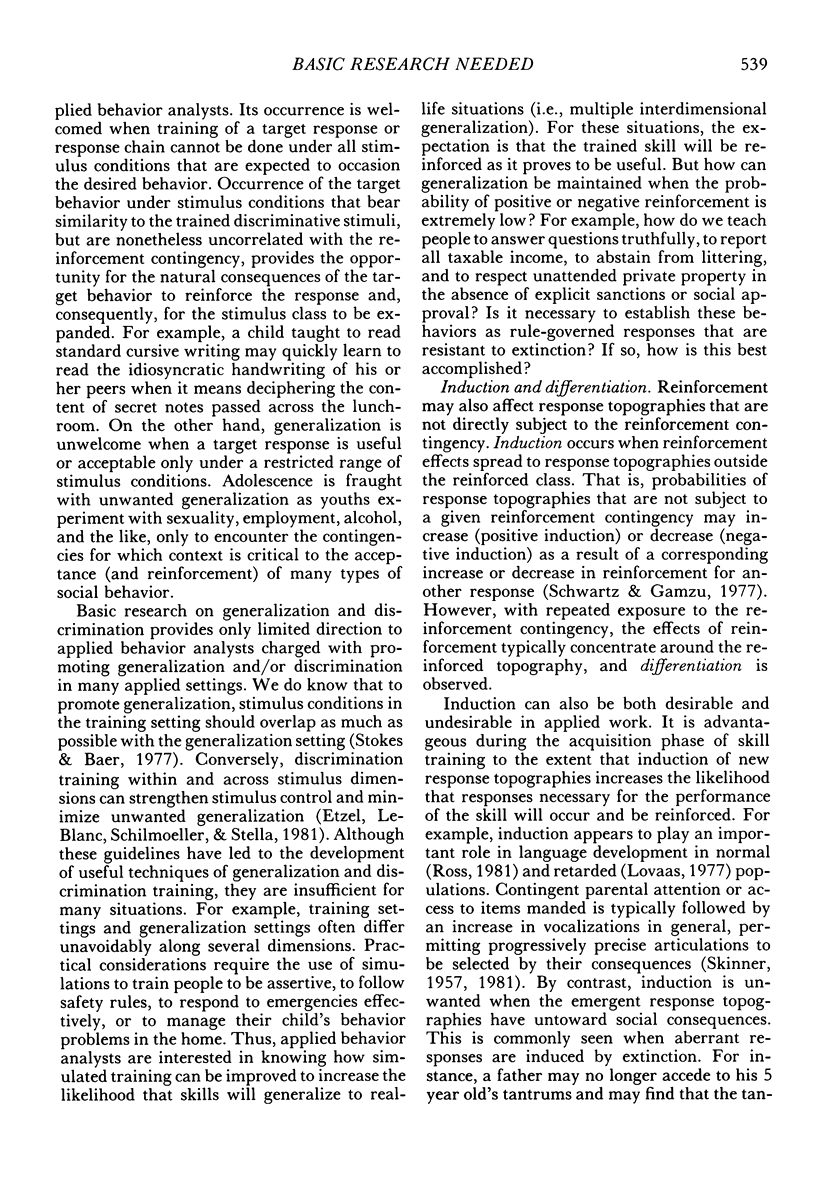
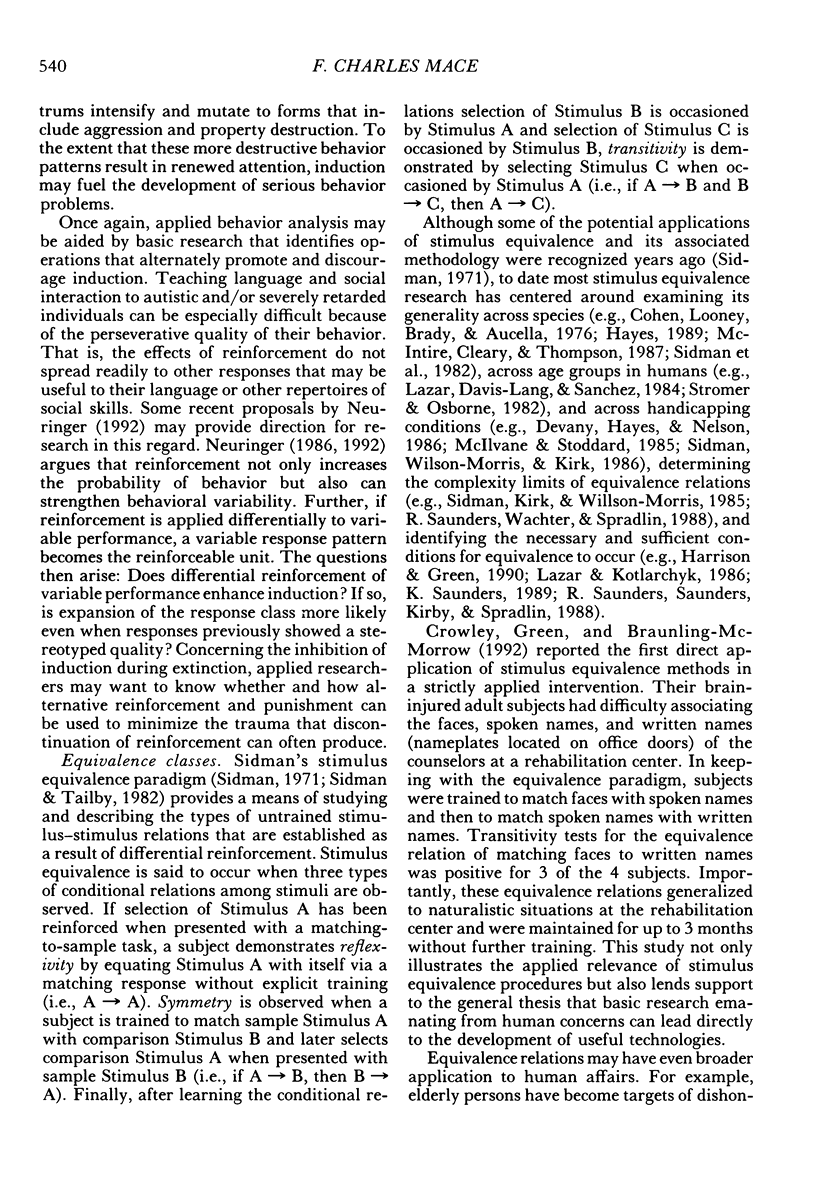
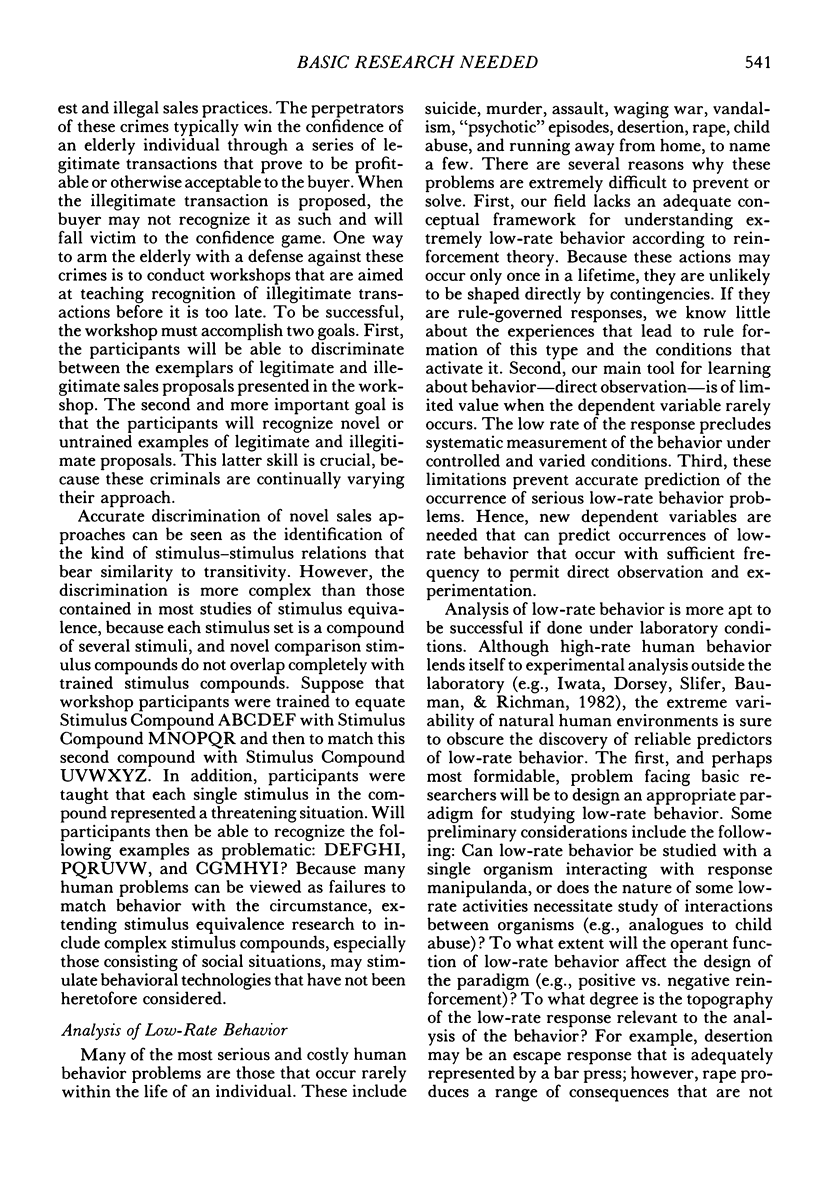
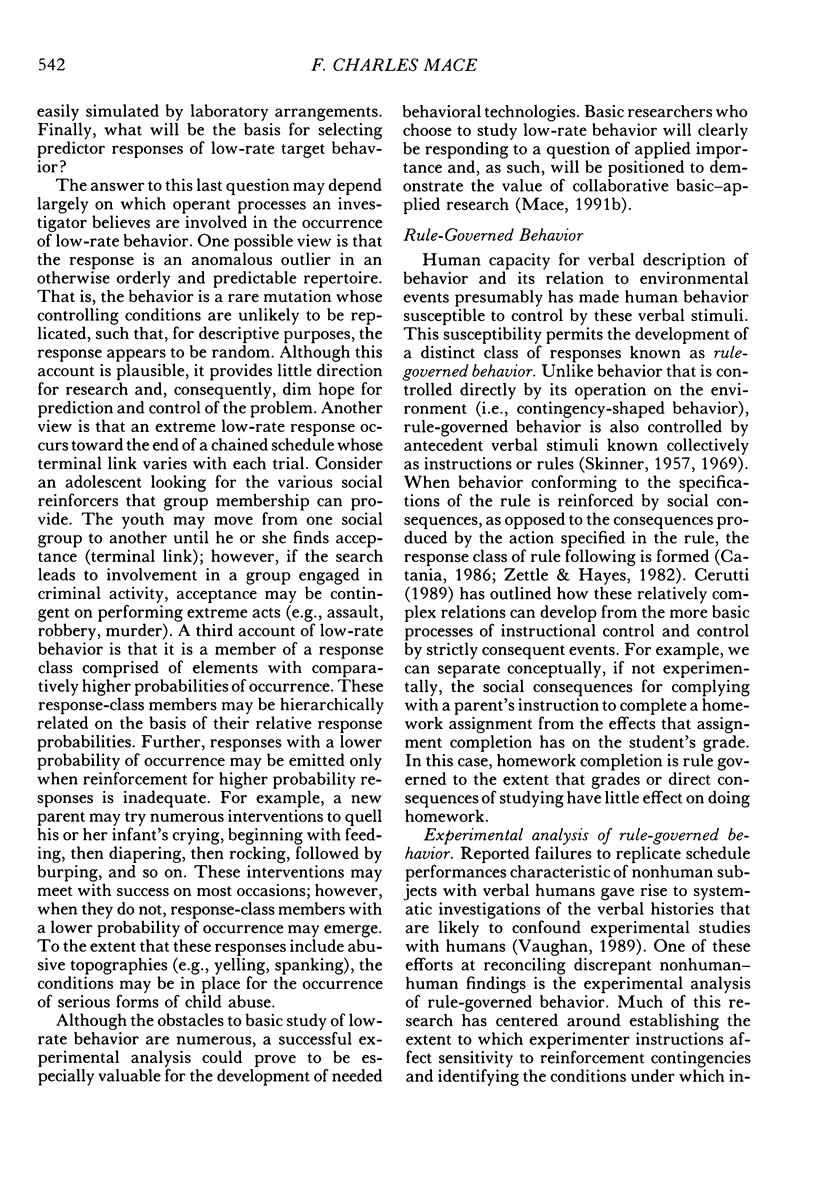
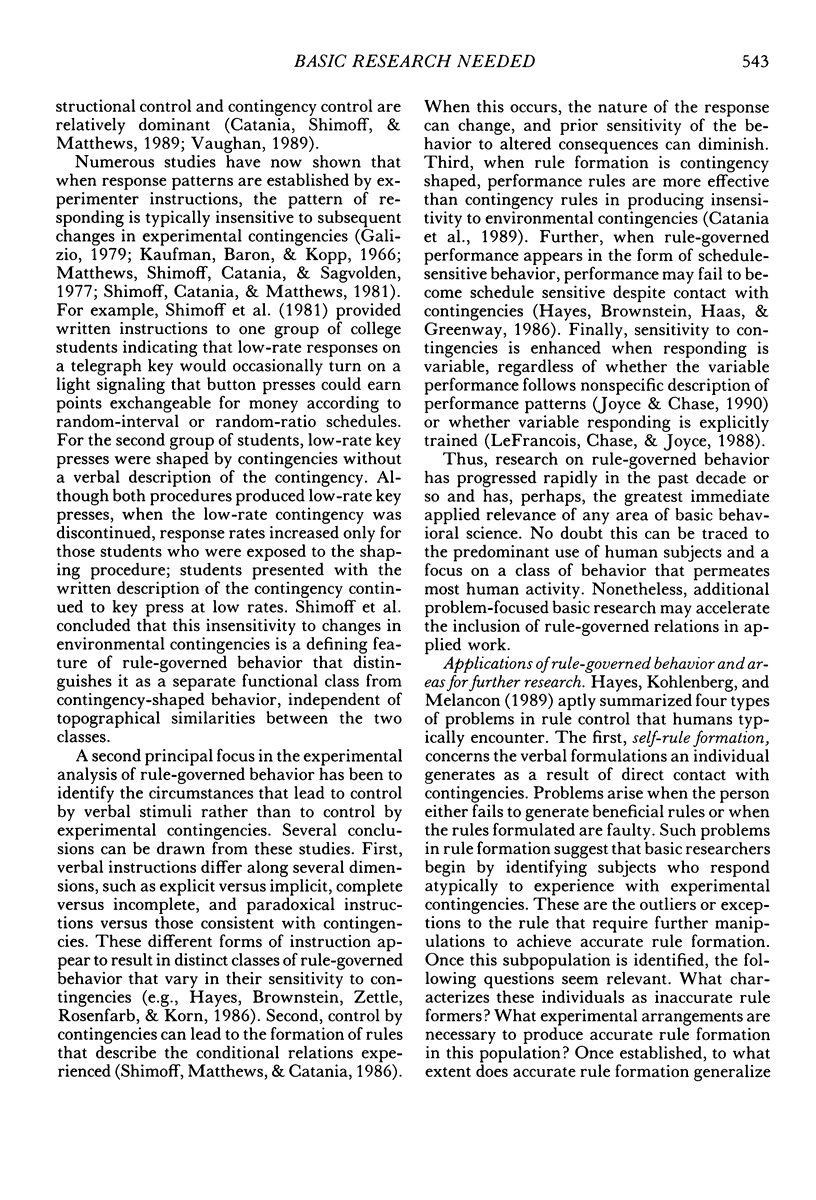
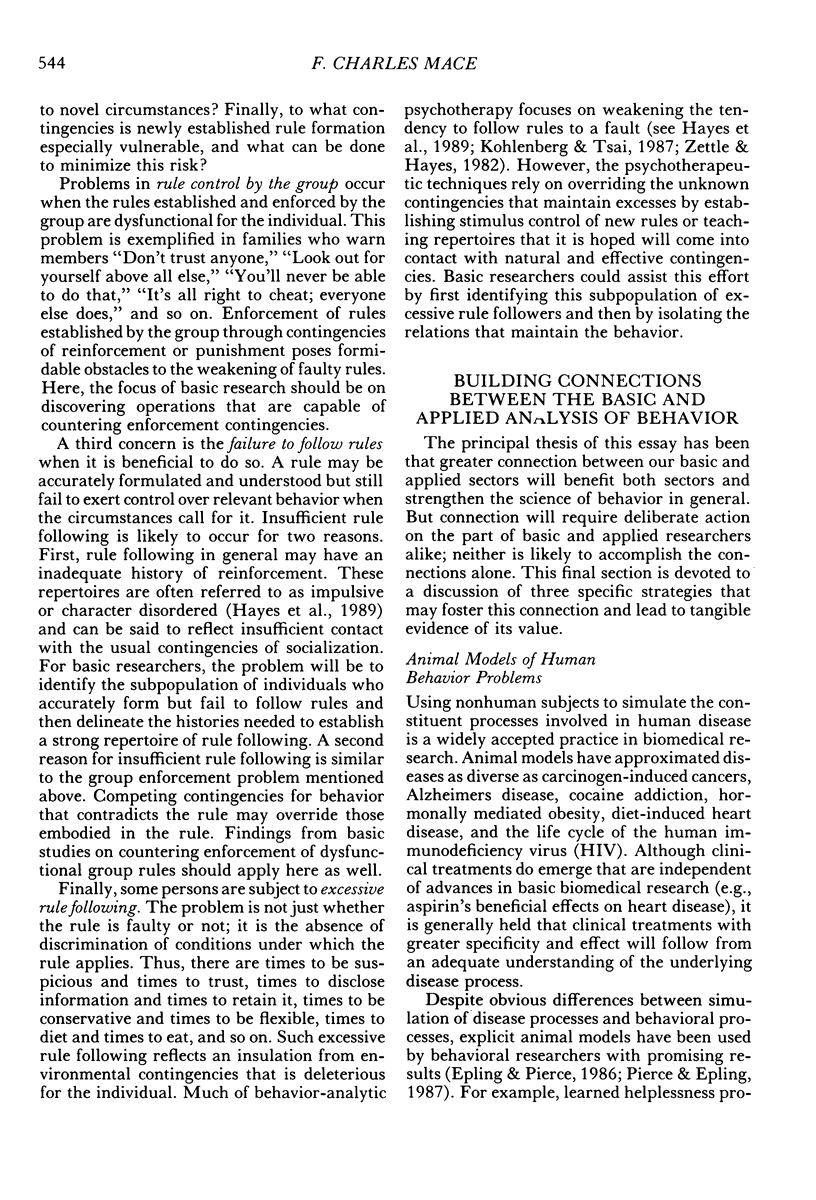
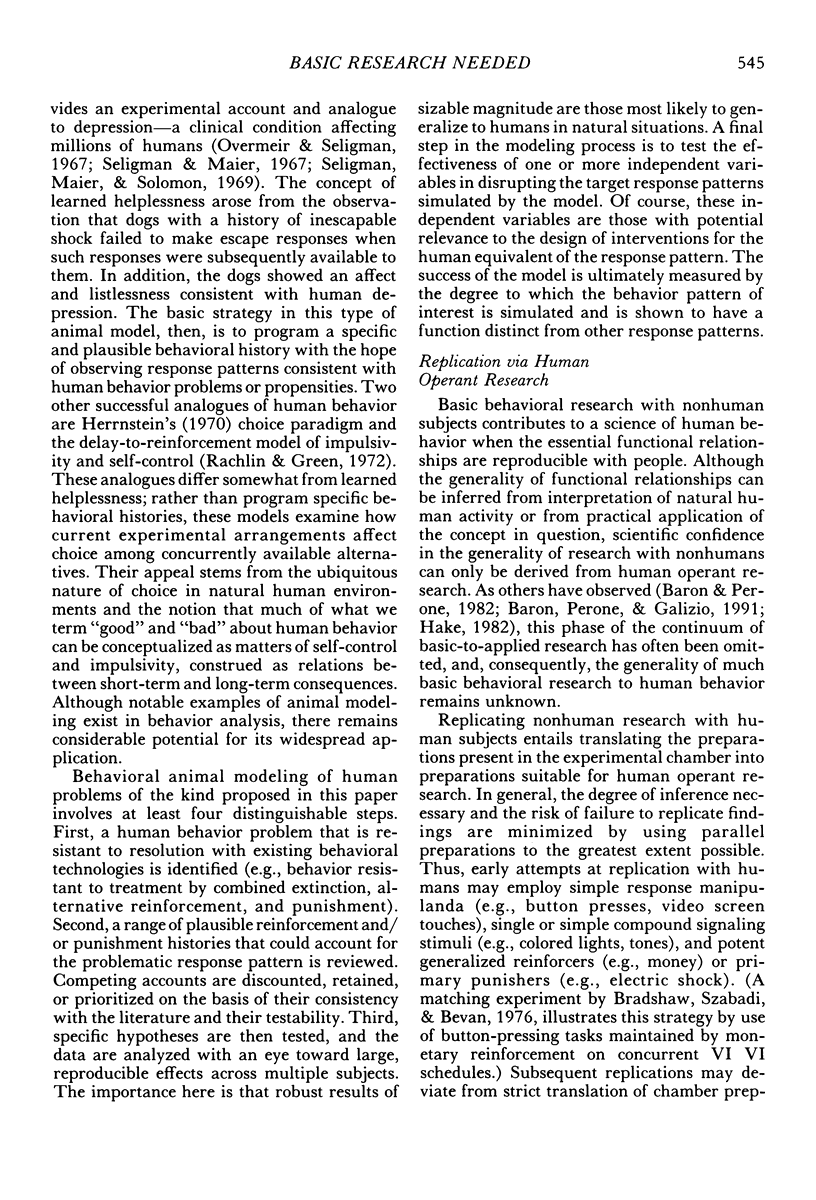
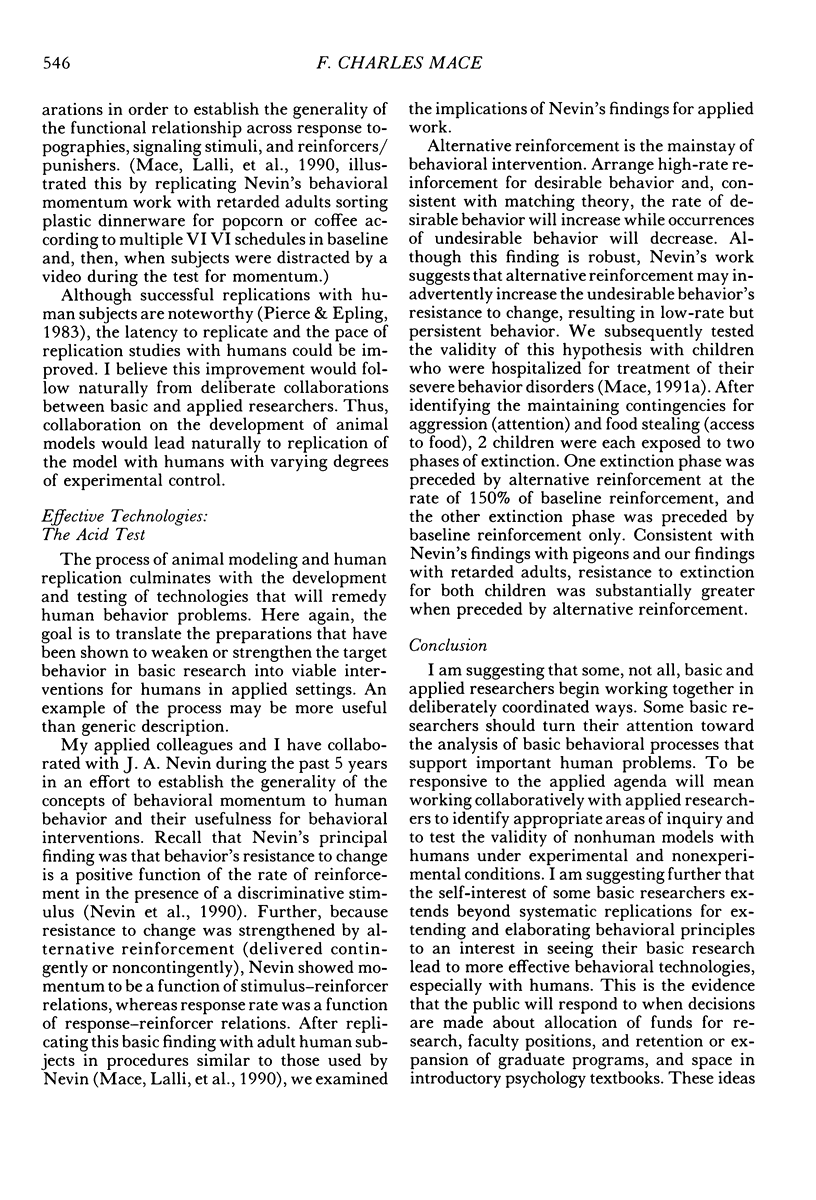
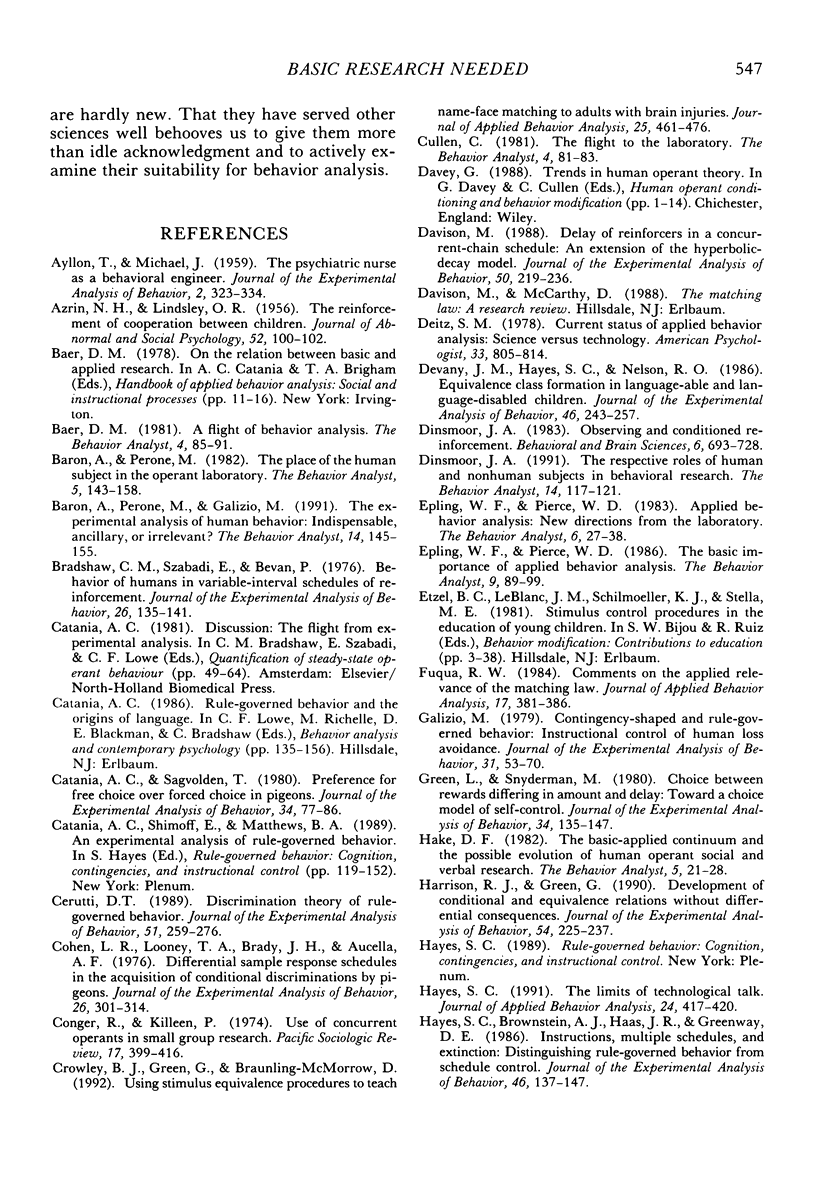
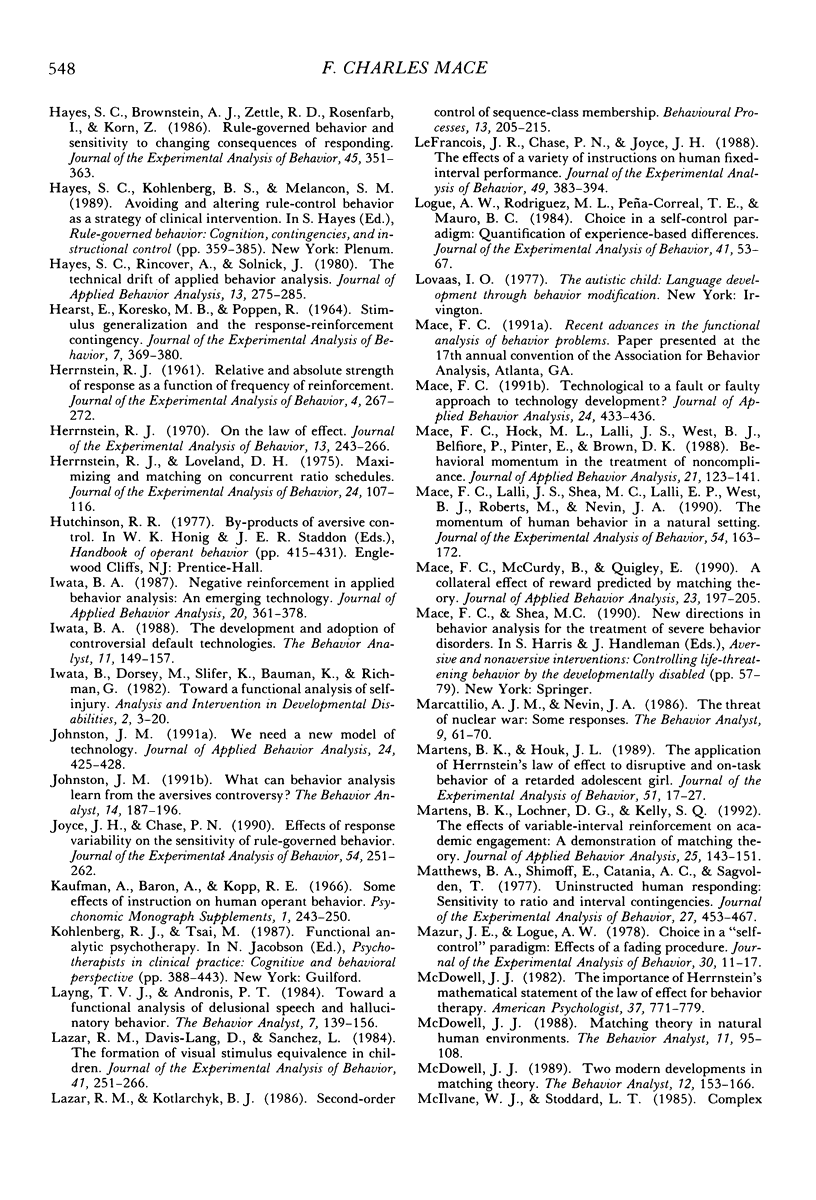
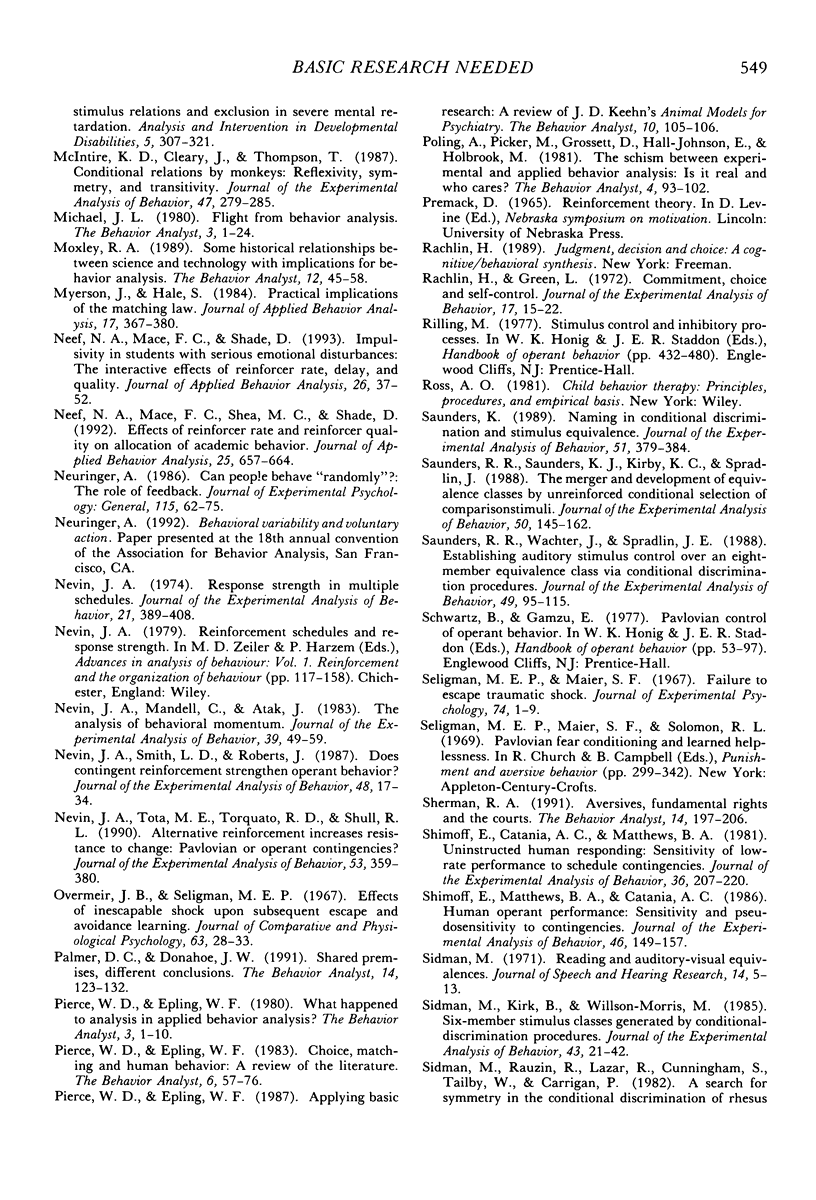
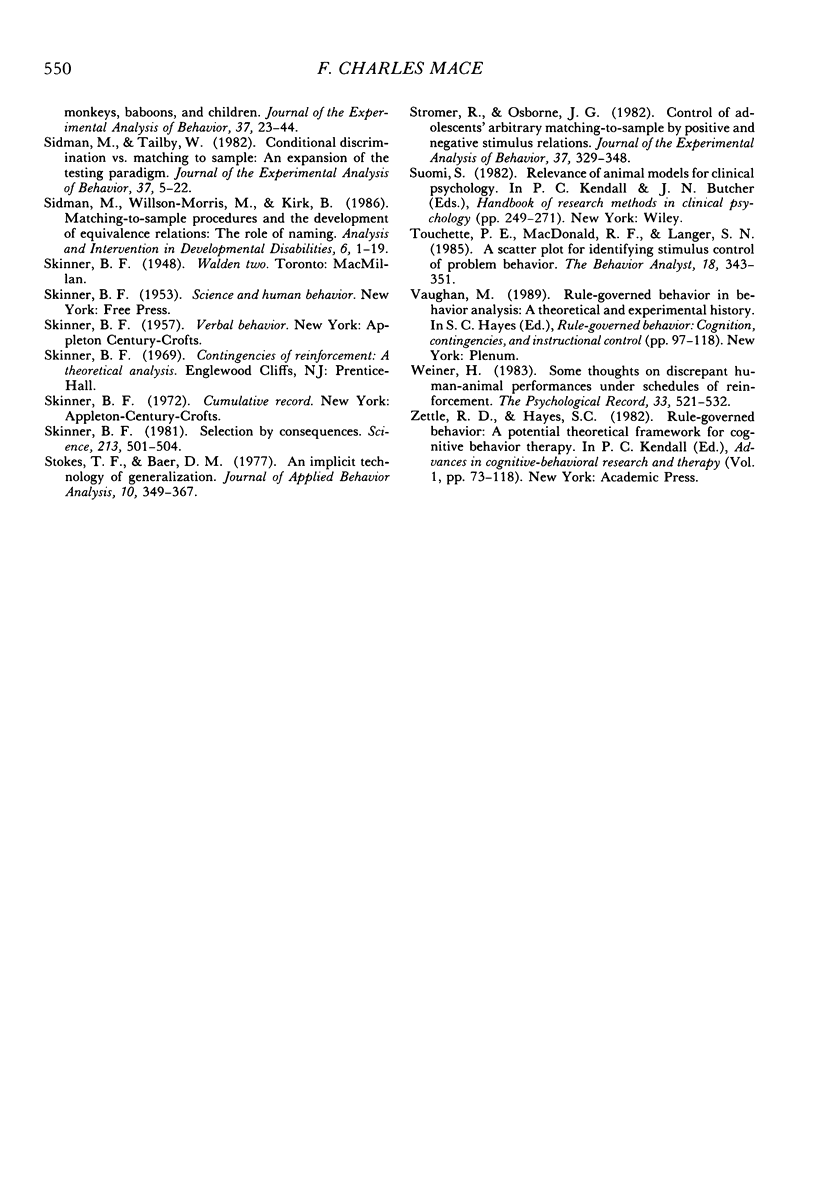
Selected References
These references are in PubMed. This may not be the complete list of references from this article.
- AYLLON T., MICHAEL J. The psychiatric nurse as a behavioral engineer. J Exp Anal Behav. 1959 Oct;2:323–334. doi: 10.1901/jeab.1959.2-323. [DOI] [PMC free article] [PubMed] [Google Scholar]
- AZRIN N. H., LINDSLEY O. R. The reinforcement of cooperation between children. J Abnorm Psychol. 1956 Jan;52(1):100–102. doi: 10.1037/h0042490. [DOI] [PubMed] [Google Scholar]
- Bradshaw C. M., Szabadi E., Bevan P. Behavior of humans in variable-interval schedules of reinforcement. J Exp Anal Behav. 1976 Sep;26(2):135–141. doi: 10.1901/jeab.1976.26-135. [DOI] [PMC free article] [PubMed] [Google Scholar]
- Catania A. C., Sagvolden T. Preference for free choice over forced choice in pigeons. J Exp Anal Behav. 1980 Jul;34(1):77–86. doi: 10.1901/jeab.1980.34-77. [DOI] [PMC free article] [PubMed] [Google Scholar]
- Cerutti D. T. Discrimination theory of rule-governed behavior. J Exp Anal Behav. 1989 Mar;51(2):259–276. doi: 10.1901/jeab.1989.51-259. [DOI] [PMC free article] [PubMed] [Google Scholar]
- Cohen L. R., Looney T. A., Brady J. H., Aucella A. F. Differential sample response schedules in the acquisition of conditional discriminations by pigeons. J Exp Anal Behav. 1976 Sep;26(2):301–314. doi: 10.1901/jeab.1976.26-301. [DOI] [PMC free article] [PubMed] [Google Scholar]
- Cowley B. J., Green G., Braunling-McMorrow D. Using stimulus equivalence procedures to teach name-face matching to adults with brain injuries. J Appl Behav Anal. 1992 Summer;25(2):461–475. doi: 10.1901/jaba.1992.25-461. [DOI] [PMC free article] [PubMed] [Google Scholar]
- Davison M. Delay of reinforcers in a concurrent-chain schedule: An extension of the hyperbolic-decay model. J Exp Anal Behav. 1988 Sep;50(2):219–236. doi: 10.1901/jeab.1988.50-219. [DOI] [PMC free article] [PubMed] [Google Scholar]
- Devany J. M., Hayes S. C., Nelson R. O. Equivalence class formation in language-able and language-disabled children. J Exp Anal Behav. 1986 Nov;46(3):243–257. doi: 10.1901/jeab.1986.46-243. [DOI] [PMC free article] [PubMed] [Google Scholar]
- Fuqua R. W. Comments on the applied relevance of the matching law. J Appl Behav Anal. 1984 Fall;17(3):381–386. doi: 10.1901/jaba.1984.17-381. [DOI] [PMC free article] [PubMed] [Google Scholar]
- Galizio M. Contingency-shaped and rule-governed behavior: instructional control of human loss avoidance. J Exp Anal Behav. 1979 Jan;31(1):53–70. doi: 10.1901/jeab.1979.31-53. [DOI] [PMC free article] [PubMed] [Google Scholar]
- Green L., Snyderman M. Choice between rewards differing in amount and delay: Toward a choice model of self control. J Exp Anal Behav. 1980 Sep;34(2):135–147. doi: 10.1901/jeab.1980.34-135. [DOI] [PMC free article] [PubMed] [Google Scholar]
- HEARST E., KORESKO M. B., POPPEN R. STIMULUS GENERALIZATION AND THE RESPONSE-REINFORCEMENT CONTINGENCY. J Exp Anal Behav. 1964 Sep;7:369–380. doi: 10.1901/jeab.1964.7-369. [DOI] [PMC free article] [PubMed] [Google Scholar]
- HERRNSTEIN R. J. Relative and absolute strength of response as a function of frequency of reinforcement. J Exp Anal Behav. 1961 Jul;4:267–272. doi: 10.1901/jeab.1961.4-267. [DOI] [PMC free article] [PubMed] [Google Scholar]
- Harrison R. J., Green G. Development of conditional and equivalence relations without differential consequences. J Exp Anal Behav. 1990 Nov;54(3):225–237. doi: 10.1901/jeab.1990.54-225. [DOI] [PMC free article] [PubMed] [Google Scholar]
- Hayes S. C., Brownstein A. J., Haas J. R., Greenway D. E. Instructions, multiple schedules, and extinction: Distinguishing rule-governed from schedule-controlled behavior. J Exp Anal Behav. 1986 Sep;46(2):137–147. doi: 10.1901/jeab.1986.46-137. [DOI] [PMC free article] [PubMed] [Google Scholar]
- Hayes S. C., Rincover A., Solnick J. V. The technical drift of applied behavior analysis. J Appl Behav Anal. 1980 Summer;13(2):275–285. doi: 10.1901/jaba.1980.13-275. [DOI] [PMC free article] [PubMed] [Google Scholar]
- Hayes S. C. The limits of technological talk. J Appl Behav Anal. 1991 Fall;24(3):417–420. doi: 10.1901/jaba.1991.24-417. [DOI] [PMC free article] [PubMed] [Google Scholar]
- Herrnstein R. J., Loveland D. H. Maximizing and matching on concurrent ratio schedules. J Exp Anal Behav. 1975 Jul;24(1):107–116. doi: 10.1901/jeab.1975.24-107. [DOI] [PMC free article] [PubMed] [Google Scholar]
- Herrnstein R. J. On the law of effect. J Exp Anal Behav. 1970 Mar;13(2):243–266. doi: 10.1901/jeab.1970.13-243. [DOI] [PMC free article] [PubMed] [Google Scholar]
- Iwata B. A. Negative reinforcement in applied behavior analysis: an emerging technology. J Appl Behav Anal. 1987 Winter;20(4):361–378. doi: 10.1901/jaba.1987.20-361. [DOI] [PMC free article] [PubMed] [Google Scholar]
- Johnston J. M. We need a new model of technology. J Appl Behav Anal. 1991 Fall;24(3):425–427. doi: 10.1901/jaba.1991.24-425. [DOI] [PMC free article] [PubMed] [Google Scholar]
- Joyce J. H., Chase P. N. Effects of response variability on the sensitivity of rule-governed behavior. J Exp Anal Behav. 1990 Nov;54(3):251–262. doi: 10.1901/jeab.1990.54-251. [DOI] [PMC free article] [PubMed] [Google Scholar]
- Lazar R. M., Davis-Lang D., Sanchez L. The formation of visual stimulus equivalences in children. J Exp Anal Behav. 1984 May;41(3):251–266. doi: 10.1901/jeab.1984.41-251. [DOI] [PMC free article] [PubMed] [Google Scholar]
- Lefrancois J. R., Chase P. N., Joyce J. H. The effects of a variety of instructions on human fixed-interval performance. J Exp Anal Behav. 1988 May;49(3):383–393. doi: 10.1901/jeab.1988.49-383. [DOI] [PMC free article] [PubMed] [Google Scholar]
- Logue A. W., Rodriguez M. L., Peña-Correal T. E., Mauro B. C. Choice in a self-control paradigm: Quantification of experience-based differences. J Exp Anal Behav. 1984 Jan;41(1):53–67. doi: 10.1901/jeab.1984.41-53. [DOI] [PMC free article] [PubMed] [Google Scholar]
- Mace F. C., Hock M. L., Lalli J. S., West B. J., Belfiore P., Pinter E., Brown D. K. Behavioral momentum in the treatment of noncompliance. J Appl Behav Anal. 1988 Summer;21(2):123–141. doi: 10.1901/jaba.1988.21-123. [DOI] [PMC free article] [PubMed] [Google Scholar]
- Mace F. C., Lalli J. S. Behavioral momentum in college basketball. J Appl Behav Anal. 1992 Fall;25(3):657–663. doi: 10.1901/jaba.1992.25-657. [DOI] [PMC free article] [PubMed] [Google Scholar]
- Mace F. C., Lalli J. S., Shea M. C., Lalli E. P., West B. J., Roberts M., Nevin J. A. The momentum of human behavior in a natural setting. J Exp Anal Behav. 1990 Nov;54(3):163–172. doi: 10.1901/jeab.1990.54-163. [DOI] [PMC free article] [PubMed] [Google Scholar]
- Mace F. C., McCurdy B., Quigley E. A. A collateral effect of reward predicted by matching theory. J Appl Behav Anal. 1990 Summer;23(2):197–205. doi: 10.1901/jaba.1990.23-197. [DOI] [PMC free article] [PubMed] [Google Scholar]
- Mace F. C. Technological to a fault or faulty approach to technology development? J Appl Behav Anal. 1991 Fall;24(3):433–435. doi: 10.1901/jaba.1991.24-433. [DOI] [PMC free article] [PubMed] [Google Scholar]
- Martens B. K., Houk J. L. The application of Herrnstein's law of effect to disruptive and on-task behavior of a retarded adolescent girl. J Exp Anal Behav. 1989 Jan;51(1):17–27. doi: 10.1901/jeab.1989.51-17. [DOI] [PMC free article] [PubMed] [Google Scholar]
- Martens B. K., Lochner D. G., Kelly S. Q. The effects of variable-interval reinforcement on academic engagement: a demonstration of matching theory. J Appl Behav Anal. 1992 Spring;25(1):143–151. doi: 10.1901/jaba.1992.25-143. [DOI] [PMC free article] [PubMed] [Google Scholar]
- Matthews B. A., Shimoff E., Catania A. C., Sagvolden T. Uninstructed human responding: sensitivity to ratio and interval contingencies. J Exp Anal Behav. 1977 May;27(3):453–467. doi: 10.1901/jeab.1977.27-453. [DOI] [PMC free article] [PubMed] [Google Scholar]
- Mazur J. E., Logue A. W. Choice in a "self-control" paradigm: effects of a fading procedure. J Exp Anal Behav. 1978 Jul;30(1):11–17. doi: 10.1901/jeab.1978.30-11. [DOI] [PMC free article] [PubMed] [Google Scholar]
- McDowell J. J. The importance of Herrnstein's mathematical statement of the law of effect for behavior therapy. Am Psychol. 1982 Jul;37(7):771–779. doi: 10.1037//0003-066x.37.7.771. [DOI] [PubMed] [Google Scholar]
- McIntire K. D., Cleary J., Thompson T. Conditional relations by monkeys: Reflexivity, symmetry, and transitivity. J Exp Anal Behav. 1987 May;47(3):279–285. doi: 10.1901/jeab.1987.47-279. [DOI] [PMC free article] [PubMed] [Google Scholar]
- Myerson J., Hale S. Practical implications of the matching law. J Appl Behav Anal. 1984 Fall;17(3):367–380. doi: 10.1901/jaba.1984.17-367. [DOI] [PMC free article] [PubMed] [Google Scholar]
- Neef N. A., Mace F. C., Shade D. Impulsivity in students with serious emotional disturbance: the interactive effects of reinforcer rate, delay, and quality. J Appl Behav Anal. 1993 Spring;26(1):37–52. doi: 10.1901/jaba.1993.26-37. [DOI] [PMC free article] [PubMed] [Google Scholar]
- Nevin J. A., Mandell C., Atak J. R. The analysis of behavioral momentum. J Exp Anal Behav. 1983 Jan;39(1):49–59. doi: 10.1901/jeab.1983.39-49. [DOI] [PMC free article] [PubMed] [Google Scholar]
- Nevin J. A. Response strength in multiple schedules. J Exp Anal Behav. 1974 May;21(3):389–408. doi: 10.1901/jeab.1974.21-389. [DOI] [PMC free article] [PubMed] [Google Scholar]
- Nevin J. A., Smith L. D., Roberts J. Does contingent reinforcement strengthen operant behavior? J Exp Anal Behav. 1987 Jul;48(1):17–33. doi: 10.1901/jeab.1987.48-17. [DOI] [PMC free article] [PubMed] [Google Scholar]
- Nevin J. A., Tota M. E., Torquato R. D., Shull R. L. Alternative reinforcement increases resistance to change: Pavlovian or operant contingencies? J Exp Anal Behav. 1990 May;53(3):359–379. doi: 10.1901/jeab.1990.53-359. [DOI] [PMC free article] [PubMed] [Google Scholar]
- Overmier J. B., Seligman M. E. Effects of inescapable shock upon subsequent escape and avoidance responding. J Comp Physiol Psychol. 1967 Feb;63(1):28–33. doi: 10.1037/h0024166. [DOI] [PubMed] [Google Scholar]
- doi: 10.1901/jeab.1986.45-351. [DOI] [PMC free article] [Google Scholar]
- Rachlin H., Green L. Commitment, choice and self-control. J Exp Anal Behav. 1972 Jan;17(1):15–22. doi: 10.1901/jeab.1972.17-15. [DOI] [PMC free article] [PubMed] [Google Scholar]
- Saunders K. J. Naming in conditional discrimination and stimulus equivalence. J Exp Anal Behav. 1989 May;51(3):379–384. doi: 10.1901/jeab.1989.51-379. [DOI] [PMC free article] [PubMed] [Google Scholar]
- Saunders R. R., Saunders K. J., Kirby K. C., Spradlin J. E. The merger and development of equivalence classes by unreinforced conditional selection of comparison stimuli. J Exp Anal Behav. 1988 Sep;50(2):145–162. doi: 10.1901/jeab.1988.50-145. [DOI] [PMC free article] [PubMed] [Google Scholar]
- Saunders R. R., Wachter J., Spradlin J. E. Establishing auditory stimulus control over an eight-member equivalence class via conditional discrimination procedures. J Exp Anal Behav. 1988 Jan;49(1):95–115. doi: 10.1901/jeab.1988.49-95. [DOI] [PMC free article] [PubMed] [Google Scholar]
- Seligman M. E., Maier S. F. Failure to escape traumatic shock. J Exp Psychol. 1967 May;74(1):1–9. doi: 10.1037/h0024514. [DOI] [PubMed] [Google Scholar]
- Shimoff E., Catania A. C., Matthews B. A. Uninstructed human responding: Sensitivity of low-rate performance to schedule contingencies. J Exp Anal Behav. 1981 Sep;36(2):207–220. doi: 10.1901/jeab.1981.36-207. [DOI] [PMC free article] [PubMed] [Google Scholar]
- Shimoff E., Matthews B. A., Catania A. C. Human operant performance: Sensitivity and pseudosensitivity to contingencies. J Exp Anal Behav. 1986 Sep;46(2):149–157. doi: 10.1901/jeab.1986.46-149. [DOI] [PMC free article] [PubMed] [Google Scholar]
- Sidman M., Kirk B., Willson-Morris M. Six-member stimulus classes generated by conditional-discrimination procedures. J Exp Anal Behav. 1985 Jan;43(1):21–42. doi: 10.1901/jeab.1985.43-21. [DOI] [PMC free article] [PubMed] [Google Scholar]
- Sidman M., Rauzin R., Lazar R., Cunningham S., Tailby W., Carrigan P. A search for symmetry in the conditional discriminations of rhesus monkeys, baboons, and children. J Exp Anal Behav. 1982 Jan;37(1):23–44. doi: 10.1901/jeab.1982.37-23. [DOI] [PMC free article] [PubMed] [Google Scholar]
- Sidman M. Reading and auditory-visual equivalences. J Speech Hear Res. 1971 Mar;14(1):5–13. doi: 10.1044/jshr.1401.05. [DOI] [PubMed] [Google Scholar]
- Sidman M., Tailby W. Conditional discrimination vs. matching to sample: an expansion of the testing paradigm. J Exp Anal Behav. 1982 Jan;37(1):5–22. doi: 10.1901/jeab.1982.37-5. [DOI] [PMC free article] [PubMed] [Google Scholar]
- Skinner B. F. Selection by consequences. Science. 1981 Jul 31;213(4507):501–504. doi: 10.1126/science.7244649. [DOI] [PubMed] [Google Scholar]
- Stokes T. F., Baer D. M. An implicit technology of generalization. J Appl Behav Anal. 1977 Summer;10(2):349–367. doi: 10.1901/jaba.1977.10-349. [DOI] [PMC free article] [PubMed] [Google Scholar]
- Stromer R., Osborne J. G. Control of adolescents' arbitrary matching-to-sample by positive and negative stimulus relations. J Exp Anal Behav. 1982 May;37(3):329–348. doi: 10.1901/jeab.1982.37-329. [DOI] [PMC free article] [PubMed] [Google Scholar]
- Touchette P. E., MacDonald R. F., Langer S. N. A scatter plot for identifying stimulus control of problem behavior. J Appl Behav Anal. 1985 Winter;18(4):343–351. doi: 10.1901/jaba.1985.18-343. [DOI] [PMC free article] [PubMed] [Google Scholar]


